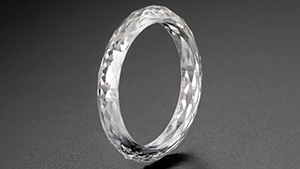
A Fancy Deep brownish orange treated HPHT-grown diamond exhibits multiple defect concentrations in various growth sectors.
Read More
The quality and size of this 4.04 ct CVD-grown diamond ring demonstrate the advancing technology in laboratory-grown diamonds.
Read More
A CVD-grown diamond submitted to GIA requires very careful examination to determine its origin.
Read More
The first report of an etch channel–like structure in a CVD laboratory-grown diamond submitted to GIA.
Read More
The quality and size of this 4.04 ct CVD-grown diamond ring demonstrate the advancing technology in laboratory-grown diamonds.
Read MoreModern gemologists use the word “jade” as a generic term for both nephrite and jadeite. These minerals have been linked throughout history.
Read More
A new type of invisible marking in CVD diamonds suggests a possible security measure.
Read More
A look at a 34.59 ct CVD-grown diamond examined at GIA’s Hong Kong laboratory.
Read More
The gemological and spectroscopic characteristics of these type IIa synthetic diamonds suggested that they experienced different growth and/or treatment histories.
Read More
A combination of trace-element analysis and UV-visible spectroscopy clearly indicated that the yellow color originated from the much more effective chromophore known as “trapped holes,” associated with the trace amount of Mg and Cr in this stone.
Read More